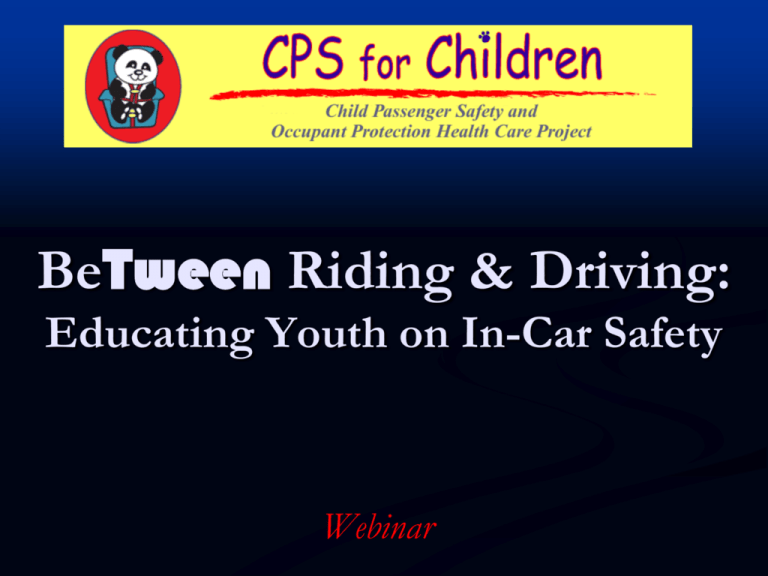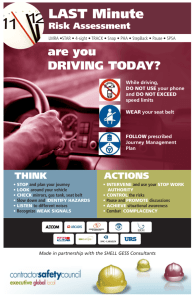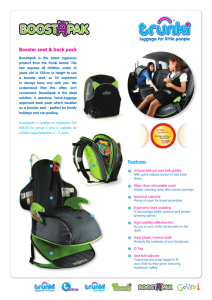Maryland Traffic Safety Laws
advertisement

BeTween Riding & Driving: Educating Youth on In-Car Safety Webinar Moderator Susanne Ogaitis-Jones, MSPH, CHES, CPST Coordinator, CPS & OP Healthcare Project Maryland Institute for Emergency Medical Services Systems This webinar was created by the Maryland Institute for Emergency Medical Services Systems, with funding from the Maryland Highway Safety Office and the National Highway Traffic Safety Administration. Goals of this webinar To educate viewers on occupant safety issues among pre-teens and provide some strategies for preventing injury/death from motor vehicle crashes among this age group. Youth in Vehicles In 2011: • about 2,500 U.S. children ages 15–19 years died as occupants in motor vehicle crashes • approximately 360,000 were injured • Among children 14 years and younger, about 800 were killed and 180,000 injured. “In crashes involving drivers younger than 18 years, the greatest risk factors for death among teen passengers are high speed roads, non-restraint use, and drivers who are ages 16 or younger.” (Winston, Arch Ped & Adol Med, 2008) Compared with younger age groups, youth age 16–24 have lower seat belt use. • In a study of 3,126 nationally representative teens who were surveyed in 2006, those who were drivers had a 82% seat belt use rate while the teen passengers had a 69% rate. Garcia. F., Durbin, DR., Winston, FK AJPH, 2012 June. 102(6). • In 2008, 80% of youth in this age group wore seat belts; the national use rate was 83%. (NHTSA) Garcia F, Durbin DR, Winston FK. Safety Belt Laws and Disparities in Safety Belt Use Among US High School Drivers. American Journal of Public Health, 2012 June; 102(6):1128-1134 They found particularly low seat belt use among specific groups of teens • Those living in rural areas • African Americans • Low grades or attending schools in lower socioeconomic districts • Those driving pickup trucks. Durbin DR, Corregano LM, Kallan MJ, Curry AE, Mirman JH, Norris C, Hill S, Winston FK. Miles to go: Focusing on Risks for Teen Driver Crashes. Published by The Children's Hospital of Philadelphia Research Institute and State Farm®, 2013. More risk factors…. In 2011, 3,331 people were killed in crashes involving driver distraction. (Centers for Disease Control) Drivers who use hand-held devices are 4 times more likely to get into crashes serious enough to injure themselves. (Monash University) Text messaging creates a crash risk 23 times worse than driving while not distracted. (Virginia Tech Traffic Inst) How to lower youth’s risk of MVC injuries and death? Education Enforcement Engineering Emergency Medical Services Encouragement Evaluation Graduated licensing has been shown to help decrease crash risk for new drivers (9%–43%; various studies) • Requires supervised early driving • Limits driving at night • Limits non-family members riding as passengers with new drivers • Increases seat belt use rates among new drivers Legislation on restraint use…. Primary seat belt laws vs Secondary seat belt laws Alonge, M. et. Al, North Central Highway Safety Network, (NHTSA Report: DOT HS 811 096) June 2012 Results from ‘Avoiding Tween Tragedies’ • Observational studies showed that seat belt use significantly improved from the pre to post study period in all groups receiving the interventions. Elementary (grades 3–5): 13% increase Middle School: 17% increase High School (15 year olds): 20% increase • Back seat positioning for elementary school students increased by 23% • Self-reporting of seat belt use and knowledge of PA seat belt laws improved across all age groups, but was most significant for the 15 year olds. Why “tweens” and Occupant Protection Education ? • • • • Cars hold wide appeal Some are already thinking about driving Increasingly riding with peers, siblings, parents of friends Many have already driven a car • • • • Pay close attention Can serve as an extra pair of eyes to driver Communicate with others Practice telling others what they learn From ‘Safest Generation,’ Safe Kids Worldwide BeTween Riding & Driving: In-Car Safety for Youth This program was created by the Maryland Institute for Emergency Medical Services Systems, with funding from the Maryland Highway Safety Office and the National Highway Traffic Safety Administration, and with additional support by the Emergency Nursing Association. Goals of the Program • Teach youth about safely riding in vehicles to reduce their risk of injury or death • Teach youth skills and information that will help them become safer drivers when they are ready to drive. Strategies Used in the Program Teach facts and consequences about riding in motor vehicles • Injury/death risks • MD driving laws (cell phone use, seat belt use, graduated licensing, drinking and driving laws) and penalties Methods: Show short video clips from the DriverCam Program, in which cameras show driver & passengers simultaneously, with the driver’s view of road. Show YouTube videos and ads on driving risks and consequences Strategies Use hands-on activities to learn and practice safety skills • proper seat belt fit demonstration • relay game to teach stowing loose objects in the car/safest positions to ride in cars/buckling up practice/look for objects near vehicles* • spot the airbag game* • Fatal Vision Goggles activity to teach the effects of impairment * Adapted from Safe Kids’ Safest Generation Strategies Use role plays to simulate common car/occupant situations and to identify youth behaviors and attitudes, then have youth practice ways of handling the situation. Strategies Use pledging to bring parents and youth together to talk about passenger safety and cooperatively establish rules, rewards, and punishments. From Safe Kids Worldwide’s, Countdown2Drive.org Pledging Process Strategies Evaluation • Pre/Post questionnaire for the youth participants • Facilitator’s feedback form • Follow up with parents Basics of the Pilot Program Pilot interventions conducted between August 2012 - June 2013 • 13 emergency nurses or safety advocates took the train-the-trainer course • Five facilitated the pilot program with youth groups (thru 2/13) • Facilitators identified youth groups, ages 10–15 yrs • One-time program lasted approximately 2 hours • Location: room with computer access; nearby use of a vehicle for hands-on exercises Experiences of Two Facilitators in the Pilot Program • Kelly Llewellyn, RN, EMS Administrative Specialist, Meritus Medical Center, Hagerstown • Oluranti Omoyeni, RN, Johns Hopkins Bayview Medical Center, Baltimore Trauma and Emergency Services Public Awareness Programs: How we are educating our community youth Kelly Llewellyn, BSN, RN EMS Administrative Specialist Child Passenger Safety Technician Where we are and who makes up our community Washington County ○ Western Maryland ○ Borders: Mason-Dixon line, Sidling Hill Creek, Potomac River, and South Mountain ○ 8 Towns ○ pop. 147,430 (2010 census) Hagerstown ○ “Hub City” located at crossroads of I-70 and I-81 ○ pop. 39,662 (‘10 census) ○ 80% Caucasian,10% African American Defensive Driving/Protective Passengers Where we went… Girls Incorporated of Washington County is a local affiliate of a national nonprofit youth organization dedicated to inspiring all girls to be strong, smart, and bold. Girls Inc. fulfills its mission of empowering girls to be self sufficient, responsible, and confident women by delivering research-based, age appropriate, after-school and summer programs. Why we went…When we went… Established contact at Girls Inc. Reach diverse group of teens November 27, 2012 4:00 - 5:30 pm Challenges… Ground rules were not clearly defined Weather: cold/rainy Darkness—parking lot not well lit; not appropriate to be outside after dark Did mock car drills inside/ Didn’t fully understand purpose of activity Lacked parent participation for Countdown2Drive piece Not all girls had access to internet Girls had difficulty reading some of the questions Didn’t have parental permission to take pictures of the event Lessons Learned Will set firm ground rules for program: no cell phones, defined times when it is okay to chat Will evaluate parking lot and lighting before event May send out a letter with the permission slip further encouraging parents to arrive at the end of the presentation in order to participate Give better directions related to the car activity as they didn’t fully understand purpose We will continue to have paper copies of the Countdown2Drive agreements We will read the test questions out loud Along with parental permission slip for class, will have picture/video release signed Who we reached… 25 girls started the program…21 completed it Data Collected 81% of the participants ranged in ages 10–12 (two-13 yo, two-14 yo, one-16 yo) 88% reported wearing seatbelts most of the time or all of the time 84% felt their parents always wear their seat belts Overall the pretest and post tests reflected similar correct answers Overall, evaluation of the program received a 5/5 Fall Planning… Girls Inc. Parish Nurse (Youth Groups) Teen MOPS Girl Scouts Stay Alive! Don’t Text and Drive. Did You Know? Distracted driving is the # 1 killer of teens It’s just like drinking and driving—using a phone while driving slows the reaction time the same amount as driving with a blood alcohol content of 0.16, TWICE the legal limit 16- and 17-year-old drivers represent 11% of all driver fatalities, but only 1.6% of all licensed Maryland drivers. 38% of all traffic injuries in Maryland involve a distracted driver 18% of fatalities in distraction-related crashes involved a cell phone Drivers who use hand held devices are four times more likely to be involved in a crash resulting in serious injury Stay Alive! Don’t Text and Drive Sponsors Stay Alive! Don’t Text and Drive Community Partners Jessica Thwaite, T-Shirt Art Contest Winner from North High!! Facebook Blog Meritus Health Website Billboard – Maryland Avenue Hagerstown, MD Where we were in the High Schools “Stay Alive!, Don’t Text and Drive.” Fall 2011 High School Football Games across Washington County Spring 2012 Frederick County High Schools-Lunch time Fall 2012 Washington County High Schools-Lunch time “Stay Alive!, Don’t Text and Drive.” Other Events Chambersburg Apple Fest Seventh-day Adventist Health Fair, Hagerstown Just Teens at Valley Mall, Hagerstown Ft. Ritchie Health Fair, Cascade Breaking Dawn Part 1, Leitersburg Cinemas-Midnight Movie Premiere Convoy of Hope, Hagerstown Greencastle Rescue Hose Fire Prevention Week, Greencastle, PA Hagerstown Sun’s Games, Hagerstown FSK Mall, Frederick Just last week… Stay Alive! Don’t Text and Drive. 12,000 students in Washington and Frederick Counties have signed the pledge Too many local teens are dying and being critically injured from car accidents… Kelly Llewellyn, BSN, RN Kelly.llewellyn@meritushealth.com (301) 790-8378 Oluranti Omoyeni RN BSN Johns Hopkins Bayview Medical Center •10–19 year olds •Parents •Church Community Outreach •Youth camp Background : Mainly of West African Ethnicity •Responsible for younger ones •Preparing for college •Culture/values •How does it feel? •Role playing •Parent time •Outside Car Park •Videos Include the parents if possible. Know cultural background. Have fun with it. Let both sides give feedback. Food/snacks Please contact: Oluranti Omoyeni (Tola) oomoyem1@jhmi.edu General Results Of First Year Of Pilot Testing From Pre-Survey to Post-Survey, there was a significant increase in awareness of: • Wearing a seat belt to stay safe instead of ‘being thrown clear in a crash’ • Graduated licensing laws • The need to safely store objects inside the car so they don’t become projectiles Observations from facilitators: The videos really captured the youths’ attention, although some were at or past their comfort zone. • The role plays were well-liked. • It was challenging to do the pledging component during the class, due to need for parents & web-accessible computers to be present. • For more information Contact: Susanne Ogaitis-Jones, MSPH, CHES, CPST MIEMSS CPS & OP Healthcare Program sogaitisjones@miemss.org or cps@miemss.org Phone: 410-706-8647





